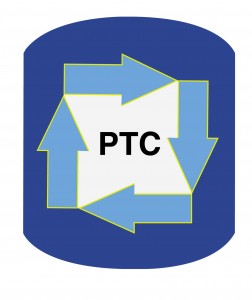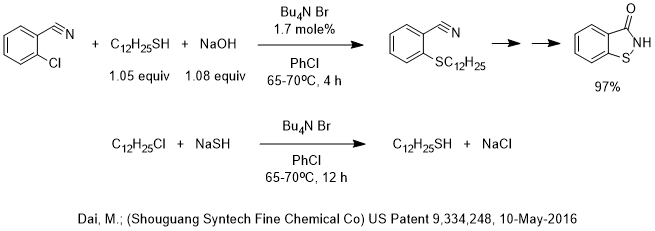This month’s PTC Tip of the Month patent describes two PTC thioetherifications, one aromatic and one aliphatic to regenerate the starting material for the aromatic thioetherification.
The first reaction is a nucleophilic aromatic thioetherification. Essentially quantitative yield is achieved at a temperature typical of other nucleophilic aromatic thioetherifications we have seen on substrates with strong electron withdrawing groups (e.g., US Patent 6,025,526). Chlorobenzene was used as the solvent for the multiple steps, which is convenient for workup and rejecting water in the organic reaction phase to enhance the reactivity of the PTC reaction. Only a small excess of the thiol was required and low phase-transfer catalyst loading was sufficient.
Dodecyl chloride is a byproduct of the synthetic route chosen. The inventors chose to react this alkyl chloride byproduct with sodium hydrosulfide to regenerate the starting material for the first reaction. Of course they chose phase-transfer catalysis for the nucleophilic aliphatic thioetherificaton like they did for the nucleophilic aromatic thioetherification.
If you study the patent in detail, note that the statement at the end of each example that reads “The organic layer is n-dodecanethiol” should be corrected to include that it contains chlorobenzene solvent or else the mass balance would be impossible.
The point is that phase-transfer catalysis excels in the nucleophilic substitutions in which alkyl mercaptides are the nucleophiles and they work extremely well for both n-aliphatic substrates and aromatic substrates with electron withdrawing groups.
On a personal note, the first project I did on my first industrial job was to develop a high yield PTC nucleophilic aromatic thioetherification using methyl mercaptide and 4-chlorobenzaldehyde back in 1984. I can attest to the fact that when you use methyl mercaptan and are a new employee who knows no one in the building, you quickly become very well known to everyone in the building.
If your company is developing or performing a commercial process that uses any organic or inorganic sulfur nucleophile, contact Dr. Marc Halpern of PTC Organics Inc. to explore how to improve your personal and corporate performance by using phase-transfer catalysis to reduce your cost of manufacture and improve your R&D efficiency.


